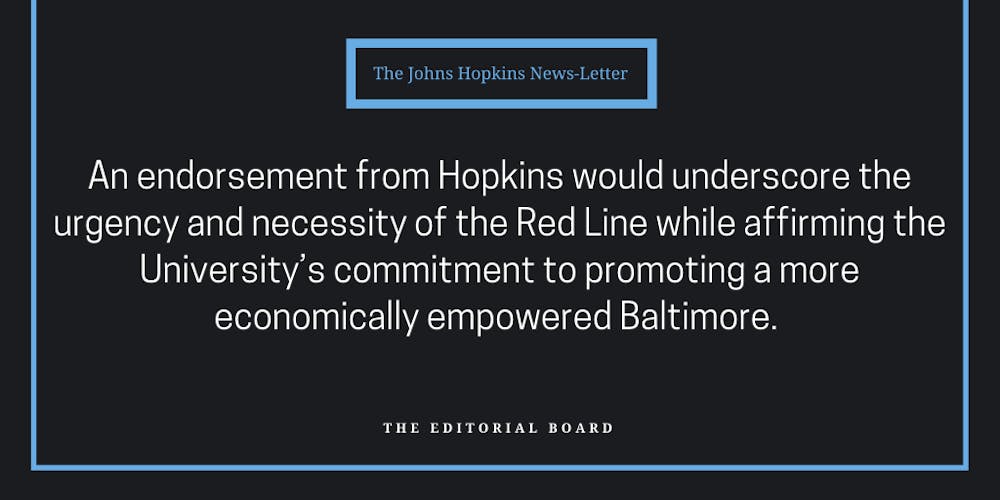Hopkins often feels distant from the city it calls home. Community engagement efforts are largely concentrated in the areas surrounding the Homewood and East Baltimore campuses. Firmly entrenched in the Hopkins Bubble, we rarely stray far from the University.
It’s not just Hopkins that is disconnected from the rest of Baltimore; separation and isolation are woven into the city itself. One clear example is the city’s poor public transportation – it’s nearly impossible to travel between East and West Baltimore without a vehicle. Taking an Uber or Lyft is expensive and unsustainable for consistent travel.
The 14-mile Red Line is a proposed light rail system that would connect East and West Baltimore through a corridor along the harbor, with stops including Fells Point and Bayview. The line was first conceived in the 1960s in order to integrate Baltimore’s numerous rail lines, serve over 40,000 workers and offer an environmentally friendly alternative to cars.
In 2008, community leaders and city officials affirmed their support for the Red Line, noting that it would empower the city economically by creating jobs and connecting Baltimoreans, particularly low-income and Black residents, to employment opportunities citywide.
We struggle to find a downside to this project.
Yet, more than 50 years since its conception, the Red Line still hasn’t been built. In June 2015, Maryland Governor Larry Hogan canceled the Red Line transit project, reallocating all of its funding to the construction of rural and suburban roads. Meanwhile, he approved the Purple Line rail, which extends 16 miles from Bethesda in Montgomery County, Maryland’s richest county, to New Carrollton in Prince George’s County.
In December 2015, the NAACP filed a complaint with the Department of Transportation, arguing that redirecting funds from the primarily Black residents of Baltimore to benefit primarily white residents in other parts of the state violated Title VI of the Civil Rights Act of 1964. The Trump administration closed the investigation without any findings in 2017.
Hogan’s decision only reinforced the systemic racism literally built into our city. Housing segregation was born in 1911 when the Mayor of Baltimore passed an ordinance prohibiting Black residents from moving to “white” neighborhoods; this ordinance was the predecessor of redlining. Today the city remains segregated, with majority-Black neighborhoods experiencing higher rates of poverty, food insecurity and health issues. By connecting East and West Baltimore, the aptly-named Red Line would have been a step toward alleviating disparities in a region still grappling with the historical effects of redlining.
The community-led Baltimore Transit Equity Coalition (BTEC) advocacy group formed in response to Hogan’s cancelation of the Red Line. The group is currently circulating a petition to garner support for the Red Line project, and it hopes to collect at least 10,000 signatures from local voters by Aug. 1 of next year.
As students, we would benefit from the Red Line and should support the BTEC’s efforts. Ultimately, however, the backing of a powerful institution like Hopkins would propel the Red Line into existence.
As the largest private employer in Baltimore and the state, Hopkins is a major stakeholder in the economy and political landscape. An endorsement from Hopkins would underscore the urgency and necessity of the Red Line while affirming the University’s commitment to promoting a more economically empowered Baltimore. Considering its wealth and resources, supporting this campaign is one simple and effective way Hopkins can serve the city.
And why wouldn’t the University support such an initiative?
The Red Line would facilitate travel between the University’s campuses. The Homewood-Bayview express shuttle has not operated since May 2020, making it difficult for those without a car to reach the Bayview Medical campus.
However, reinstating this shuttle route won’t address the core issue. Services exclusive to Hopkins only further alienate us from the surrounding community and fail to address the deep-seated inequity. If the Red Line existed, we wouldn’t need a shuttle service to Bayview in the first place.
For Homewood students, the Red Line could be accessed in conjunction with traveling on the Charm City Circulator’s Purple route.
Few students are aware of the rich history of “The Avenue” in West Baltimore, which was a bustling Black business and entertainment district until the late 1960s. Improved public transportation would allow them to attend a jazz concert in nearby historic Lafayette Square or explore Everyone’s Place Bookstore and African Cultural Center, one of fewer than 200 Black-owned bookstores in the United States.
We look forward to the day when the Red Line runs through Baltimore, and we urge Hopkins to help make it happen.
If you are interested in signing the BTEC’s petition to build the Red Line, you can visit the organization every Saturday at the 32nd Street Farmers Market located at 400 East 32nd Street.
Correction: The original version of this article substituted the term Black-led for community-led.
The News-Letter regrets these errors.





